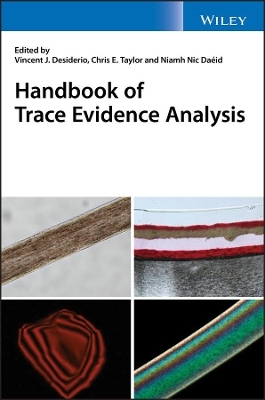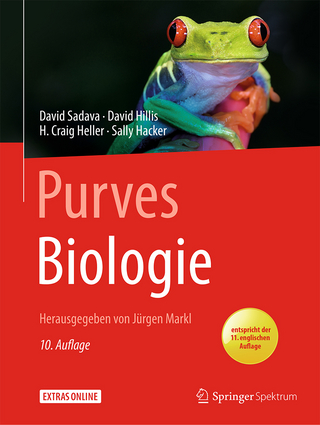
Handbook of Trace Evidence Analysis
John Wiley & Sons Inc (Verlag)
978-1-118-96211-4 (ISBN)
Developed around the need for updated information in the disciplines of trace evidence the Handbook of Trace Evidence Analysis focuses on the increasing awareness and need for validation, modern methods for addressing and controlling contamination, the shift towards incorporating statistical analyses into the interpretation phase and cutting edge research into new forensic science methods and their application.
Beginning with an overview of the topic and discussing the important role that information derived from trace materials can provide during investigations, the book then presents chapters on key techniques. The first being the critical nature of microscopy, and the methods employed for the recognition, collection, and preservation of trace evidence. Subsequent chapters review the core disciplines of trace evidence examination: paints and polymers, hairs, fibers and textiles and glass. Each chapter contains in-depth discussions on the origin of the materials involved, including any natural or synthetic processes involved in their production, the nuances involved in their detection, and the methods of analysis that are used to extract valuable information from samples. In addition, suggested workflows in method and testing selections, as well as addressing specific scientific challenges as well as the limitations of knowledge on the transfer, persistence and background abundance of trace materials are discussed. The book ends by examining the interpretation of trace evidence findings from a historical perspective and examining the methods that are currently being developed.
Provides an in-depth introduction to the general area of trace evidence and discusses current and new techniques
Consolidates trace evidence and materials categories of testing into one reference series
Offers a detailed focus on technical approaches and guidelines to trace evidence
Includes analytical schemes/workflows and valuable guides for the interpretation of data and results
The Handbook of Trace Evidence will appeal to forensic science academics, students, and practitioners in the trace evidence and materials science disciplines, as well as DNA analysts, toxicologists, forensic anthropologists, crime laboratory managers, criminal justice students and practitioners, and legal professionals. It would also be a valuable resource for every crime laboratory reference library.
Vincent J. Desiderio is the Hazardous Materials Program Specialist for the United States Postal Inspection Service-Security Group, Washington, D.C. Chris E. Taylor is a Forensic Chemist at the Defense Forensic Science Center-US Army Criminal Investigation Laboratory in Forest Park, Georgia. Niamh Nic Daéid, PhD, is Professor of Forensic Science and Director of the Leverhulme Research Centre for Forensic Science, School of Science and Engineering, University of Dundee, Scotland.
List of Contributors xv
Preface xvii
1 Trace Evidence Recognition, Collection, and Preservation 1
Ted R. Schwartz, Daniel S. Rothenberg, and Brandi L. Clark
1.1 Introduction 1
1.2 Theories of Transfer and Persistence 1
1.2.1 Locard’s Exchange Principle 1
1.2.2 Primary, Secondary, Tertiary, etc. Transfers 2
1.2.3 Non-contact Transfers 4
1.2.4 Patterns Due to Contact 4
1.2.5 Factors Affecting the Likelihood of a Transfer 5
1.2.6 Factors Affecting Persistence 5
1.3 Proper Evidence Handling Practices 6
1.3.1 Proper Clothing to Wear and Why 7
1.3.2 Other Techniques to Avoid Contamination and Loss 7
1.4 Recognition, Collection, and Preservation of Trace Evidence at the Crime Scene 8
1.4.1 Searching for Relevant Trace Evidence 9
1.4.1.1 Visible Trace Evidence 9
1.4.1.2 Invisible Trace Evidence 9
1.4.2 Documentation 9
1.4.3 Collection 10
1.4.3.1 Collecting the Entire Item Containing Potential Trace Evidence 11
1.4.3.2 Picking with a Gloved Hand or Tweezers 13
1.4.3.3 Collecting Invisible Trace Evidence 14
1.4.3.4 Tape Lifting 14
1.4.3.5 Vacuum Sweeping 15
1.4.3.6 Tape Lifting vs. Vacuum Sweeping: Which Method to Use? 16
1.4.3.7 Other Techniques 16
1.4.4 Taking Known Exemplars and Alibi Samples 17
1.4.5 Collection of Trace Evidence from a Body 18
1.4.6 Preserving Evidence and Maintaining the Chain of Custody 19
Checklist: Crime Scene Procedures 19
Components of a Crime Scene Kit for Trace Evidence Collection 20
1.5 Recognition, Collection, and Preservation of Trace Evidence in the Laboratory 21
1.5.1 Workspace Preparation 21
Checklist: Preparation of Examination Area in the Laboratory 21
1.5.2 Evidence Examination Considerations 22
1.5.3 Initial Examination Considerations 22
A Note Regarding Evidence Handling and Potential DNA Contamination 22
1.5.4 Evidence Description 23
1.5.5 Macroscopic Evidence Examination 23
1.5.6 Stereomicroscopic Examination 23
1.5.7 Additional Documentation 24
1.5.8 The Collection of Trace Evidence from Items in the Laboratory 25
1.5.9 Collection Techniques 25
1.5.9.1 Picking off Observed Trace Evidence 25
1.5.9.2 Shaking/Scraping 26
1.5.9.3 Tape Lifting 27
1.5.9.4 Vacuum Sweeping 27
1.5.9.5 Combinations of the Above Methods 28
1.5.10 Taking Known Exemplar Samples 28
Checklist: Evidence Examination in the Laboratory 28
1.6 Summary 29
Acknowledgments 29
References 29
Further Reading 30
2 Polarized Light Microscopy for the Trace Evidence Examiner 32
Andrew M. Bowen
2.1 Introduction 33
2.2 The Nature of Light 34
2.2.1 Reflection 35
2.2.2 Refraction 36
2.2.3 Dispersion 40
2.2.4 Temperature Coefficient of Refractive Index 41
2.2.5 Absorption of Light 41
2.2.6 Other Interactions Between Light and Matter 41
2.3 Light Microscopy 42
2.3.1 Image Formation in a Compound Light Microscope 42
2.3.2 Numerical Aperture and Resolution 45
2.4 Introduction to Crystallography 55
2.4.1 Symmetry 55
2.4.2 Crystal Point Groups 57
2.4.3 Six Crystal Systems 58
2.4.3.1 Cubic (Isometric) System 58
2.4.3.2 Tetragonal System 60
2.4.3.3 Hexagonal System 60
2.4.3.4 Orthorhombic System 62
2.4.3.5 Monoclinic System 62
2.4.3.6 Triclinic System 63
2.4.4 Crystal Morphology 64
2.4.4.1 Miller Indices 65
2.4.4.2 Crystal Forms and Crystal Habit 67
2.4.4.3 Crystal Morphology Through the Light Microscope 68
2.5 Introduction to Optical Crystallography 69
2.5.1 Optics of Isotropic Substances 69
2.5.2 Optics of Uniaxial Substances 75
2.5.3 Optics of Biaxial Substances 84
2.5.3.1 Optic Axial Plane and Optic Normal 88
2.5.3.2 Acute Bisectrix, Obtuse Bisectrix, Optic Sign, and Optic Axial Angle 90
2.5.3.3 Optical Orientation 91
2.5.3.4 Dispersion in Biaxial Crystals 93
2.6 Measurement of Optical Properties 94
2.6.1 Measurement of Refractive Index Values: Isotropic Substances 95
2.6.1.1 Becke Line Immersion Method 97
2.6.1.2 Single Variation Method 99
2.6.1.3 Emmons Double Variation Method 100
2.6.2 Measurement of Refractive Indices in Uniaxial Substances 100
2.6.3 Measurement of Refractive Index in Biaxial Substances 105
2.6.4 Retardation 107
2.6.5 Birefringence 113
2.6.6 Extinction Characteristics 120
2.6.7 Use of Compensators and Sign of Elongation 129
2.6.8 Conoscopic Observations of Uniaxial Substances 134
2.6.9 Conoscopic Observations on Biaxial Substances 142
2.6.10 Updated Measurement of Refractive Index Values: Uniaxial Substances 150
2.6.11 Updated Measurement of Refractive Index Values: Biaxial Substances 151
2.6.12 The Spindle Stage 151
2.7 Identification of an Unknown Using Optical Properties 152
2.7.1 Applications of Light Microscopy to Trace Evidence 155
References 156
3 Paints and Polymers 157
Robyn B. Weimer, Diana M. Wright, and Tamara Hodgins
3.1 Introduction to the Paint and Polymer Discipline 157
3.2 Overview of Polymer Chemistry 159
3.2.1 Introduction to Polymers 159
3.2.2 Polymer Synthesis 159
3.3 Overview of Coatings 160
3.3.1 Chemistry and Terminology of Coatings 160
3.3.1.1 Binders 161
3.3.1.2 Pigments 161
3.3.1.3 Additives 163
3.3.1.4 Volatile Components 163
3.3.2 Manufacturing Considerations 163
3.3.3 Application Processes 164
3.3.3.1 Spraying 164
3.3.3.2 Dipping 165
3.3.3.3 Electrodeposition 165
3.3.4 Types of Coatings and End Uses 166
3.3.4.1 Automotive Coatings 166
3.3.4.2 Architectural Coatings 171
3.3.4.3 Vehicular Non-automotive Coatings 173
3.3.4.4 Tool Coatings 174
3.3.4.5 Other/Specialty Coatings 174
3.3.5 Other Polymeric Materials 177
3.3.5.1 Buttons, Hair Beads, Jewelry, and Synthetic Fingernails 177
3.3.5.2 Gasoline Cans 177
3.3.5.3 Plastic Bags 178
3.3.5.4 Gloves 178
3.3.5.5 Automotive Parts and Panels 178
3.3.5.6 Decals 178
3.3.5.7 Paintballs 179
3.3.5.8 Glitter 179
3.3.5.9 Foam 179
3.4 Forensic Examination 180
3.4.1 Recognition, Collection, and Preservation 180
3.4.1.1 Gross Examination 180
3.4.1.2 Visual Recovery and Collection 182
3.4.1.3 Recovery by Scraping 182
3.4.2 Analytical Scheme 184
3.4.2.1 Physical Fit 184
3.4.2.2 Comparison 185
3.4.2.3 Exposing of Layers 186
3.4.2.4 Physical Characteristics to Note 188
3.4.2.5 Further Testing 192
3.5 Paint Databases 199
3.5.1 The Royal Canadian Mounted Police Paint Data Query Database 200
3.6 Interpretation and Report Considerations 206
References 210
4 Forensic Hair Microscopy 219
Jason C. Beckert
4.1 Introduction 219
4.1.1 History 219
4.2 Chemistry and Histology 221
4.2.1 Basic Chemistry 221
4.2.2 Basic Histology 222
4.2.3 Cuticle 223
4.2.4 Cortex 224
4.2.5 Medulla 225
4.2.6 Cell Membrane Complex 225
4.2.7 Follicle 225
4.3 Physiology 225
4.3.1 Hair Cycle 225
4.3.1.1 Timing 226
4.3.1.2 Shedding 227
4.3.2 Growth Rates 228
4.3.3 Changes with Age 228
4.3.3.1 Hair Color, Graying, and Baldness 229
4.4 Collection and Isolation 230
4.4.1 Questioned Samples 230
4.4.1.1 Techniques 230
4.4.1.2 Other Considerations 232
4.4.2 Known Samples 233
4.5 General Hair 235
4.5.1 Types of Hair 235
4.5.1.1 Human 235
4.5.1.2 Animal 236
4.5.2 Basic Microscopy 237
4.5.2.1 Cuticle 238
4.5.2.2 Cortex 239
4.5.2.3 Medulla 241
4.5.3 Basic Hair Identification 241
4.5.4 Human Versus Animal Hair 242
4.6 Human Hair Examinations 245
4.6.1 Somatic Origin 245
4.6.2 Ancestry 247
4.6.3 Cosmetic Treatment 249
4.6.4 Shaft Abnormalities 252
4.6.5 Hair End Morphology 254
4.6.5.1 Typical Root Morphology 254
4.6.5.2 General Significance 256
4.6.5.3 Suitability for DNA Testing 256
4.6.5.4 Postmortem Changes 257
4.6.5.5 Other Atypical Root Morphologies 259
4.6.5.6 Non-root Morphologies 259
4.6.6 Degradation 262
4.6.6.1 Weathering 262
4.6.6.2 Heat 264
4.6.6.3 Biodeterioration 265
4.6.6.4 Other General Changes 268
4.7 Human Hair Comparisons 268
4.7.1 Comparison Guidelines 269
4.7.1.1 Macroscopic Observations and Stereomicroscopy 269
4.7.1.2 Compound Light Microscopy 269
4.7.1.3 Comparison Microscopy 270
4.7.2 Conclusions and Interpretation 272
4.7.2.1 Association 272
4.7.2.2 Inconclusive 274
4.7.2.3 Exclusion 274
4.8 Transfer and Persistence 275
4.9 Animal Hair 279
4.9.1 Identification 280
4.9.2 Cats and Dogs 283
4.9.3 Textile Fur Fibers 286
4.10 Specialized Techniques 287
4.10.1 Examination of the Cuticular Surface 287
4.10.2 Transverse Cross-sections 289
4.10.3 Longitudinal Cross-sections 291
4.11 Practical Considerations 294
4.11.1 Training 294
4.11.2 Reference Collections 295
4.11.3 Examination Guidelines 296
4.11.4 Documentation, Report Writing, and Testimony 298
4.12 Criticisms 299
4.12.1 Probability 299
4.12.2 FBI Review 300
4.13 Summary: The Value of Forensic Hair Microscopy 301
References 304
5 Fibers 322
Sandra Koch and Kornelia Nehse
5.1 Introduction to Forensic Fiber Analysis 322
5.2 Fiber Overview 323
5.2.1 Textile Production: Fiber – Yarn/Cordage – Fabric 323
5.2.2 Fiber Types 328
5.2.2.1 Natural Fibers 328
5.2.2.2 Manufactured Fibers 332
5.2.3 Fiber/Textile Coloration 338
5.3 Forensic Fiber Examination Background 339
5.3.1 Transfer and Persistence 339
5.3.2 Collection 342
5.3.2.1 Recognition, Collection, and Preservation 342
5.3.2.2 Collection 343
5.3.2.3 Visual Recovery: Picking 343
5.3.2.4 Other Recovery Methods: Taping, Scraping, and Vacuuming 343
5.3.3 Identification 344
5.3.3.1 Natural Fiber Identification 345
5.3.4 Comparison 351
5.4 Microscopical Analysis 352
5.4.1 Stereomicroscopy 353
5.4.2 Brightfield Microscopy 354
5.4.3 Polarized Light Microscopy 354
5.4.4 Fluorescence Microscopy 355
5.4.5 Comparison Microscopy 355
5.4.6 Scanning Electron Microscopy 356
5.5 Instrumental Analysis 356
5.5.1 Microspectrophotmetry: UV-Visible 356
5.5.2 Fourier Transform Infrared Spectroscopy 357
5.5.3 Raman Spectroscopy 358
5.5.4 Other Analytical Techniques (Non-routine) 359
5.5.4.1 Thin-layer Chromatography 359
5.5.4.2 Pyrolysis-Gas Chromatography Mass Spectrometry and Pyrolysis-Mass Spectrometry 361
5.5.4.3 High-Performance Liquid Chromatography 361
5.5.4.4 Melting Point 361
5.6 Microscopic Characteristics to Note in Forensic Fiber Examinations 361
5.7 Optical Properties 361
5.8 Chemistry 362
5.8.1 Solubility Testing 362
5.9 Forensic Examination 363
5.9.1 Analytical Scheme 363
5.9.2 Fabric and Cordage Examinations 363
5.9.2.1 Fabric Damage 363
5.9.2.2 Cordage 368
5.10 Interpretation and Reporting 368
5.10.1 Interpretation 368
5.10.2 Report Writing 369
5.11 Testimony 370
References 370
6 Interpretation of Glass Evidence 377
James Curran, Tacha Hicks, and Tatiana Trejos
6.1 Introduction to Glass Examination 377
6.1.1 Composition, Manufacture, and Distribution 378
6.1.2 Forensic Examination Protocols 380
6.1.3 Refractive Index 380
6.1.4 Refractive Index Annealing 382
6.1.5 Elemental Analysis of Glass 382
6.1.5.1 SEM-EDS 383
6.1.5.2 Micro-X-Ray Fluorescence 383
6.1.5.3 ICP Methods 383
6.1.5.4 LIBS 385
6.1.6 Comparison of Discrimination Capabilities of the Methods of Analysis 386
6.2 Introduction to the Interpretation of Glass Evidence 387
6.2.1 Formulation ofWorking Propositions and Case Pre-assessment 388
6.2.2 Evaluation of Results Given Source Level Propositions 390
6.2.3 Evaluation of Results Given Activity Level Propositions 391
6.2.4 A Note on the Use of “Contact” or Pseudo-Activity Level Propositions 391
6.2.5 Evaluation of Results Given Offence Level Propositions 392
6.2.6 Evaluation of Results Given Source Level Propositions 393
6.2.7 The Two-Stage Approach 394
6.2.7.1 Interpretation Based on RI Measurements 394
6.2.7.2 Student’s t-Test 397
6.2.7.3 Interpretation Based on Elemental Analysis Measurements 401
6.2.7.4 Match Steps for Elemental Analysis 402
6.2.7.5 Disadvantages of the Two-Stage Approach 404
6.2.8 The Continuous Approach 404
6.2.8.1 Interpretation Based on RI Measurements 405
6.2.8.2 Interpretation Based on Elemental Analysis Measurements 407
6.2.8.3 Evaluation of Results Given Activity Level Propositions 408
6.2.8.4 Example 1: One Group, One Control 409
6.2.9 Assigning Background and Transfer Probabilities 410
6.3 Concluding Remarks 412
References 413
7 Interpreting Trace Evidence 421
Patrick Buzzini and James M. Curran
7.1 What is Evidence Interpretation? 421
7.2 A Process of Uncertainties 422
7.3 Factors Affecting Evidence Interpretation 426
7.3.1 The Context of the Case 426
7.3.2 The Questions Directed to the Forensic Scientist and Hypothesis Formulation 427
7.3.3 Extent of Collected Analytical Information, Reliability, and Validity 429
7.3.4 The Degree of Similarity Between Compared Sets 431
7.4 Some Interpretive Issues: The Example of the Birmingham Six Bombing Case 432
7.4.1 Prosecutor’s Fallacy or the Transposed Conditional 433
7.4.2 Inappropriate Level of Propositions 434
7.4.3 Misconception of the 99% 434
7.4.4 Non-consideration of Plausible Defense Arguments 435
7.5 The Bayesian Approach 436
7.6 Implications of Expert Conclusions from Comparative Examinations: An Example with Fiber Evidence 438
7.6.1 Conclusion 1: Factual Reporting 439
7.6.2 Conclusion 2: Consistent with, Cannot Be Excluded, and Reasonable Degree of Certainty 439
7.6.3 Conclusion 3: High Discriminating Procedure 439
7.6.4 Conclusion 4: Rarity Assessment of the Suspected Source 439
7.6.5 Conclusion 5: “Association Key” Verbal Scale 440
7.6.6 Conclusion 6: Likelihood Ratio Verbal Scale 442
7.7 Conclusion 446
Acknowledgments 447
References 447
Index 455
| Erscheinungsdatum | 16.10.2020 |
|---|---|
| Verlagsort | New York |
| Sprache | englisch |
| Maße | 183 x 257 mm |
| Gewicht | 1179 g |
| Themenwelt | Naturwissenschaften ► Biologie |
| Naturwissenschaften ► Chemie | |
| ISBN-10 | 1-118-96211-7 / 1118962117 |
| ISBN-13 | 978-1-118-96211-4 / 9781118962114 |
| Zustand | Neuware |
| Haben Sie eine Frage zum Produkt? |
aus dem Bereich


